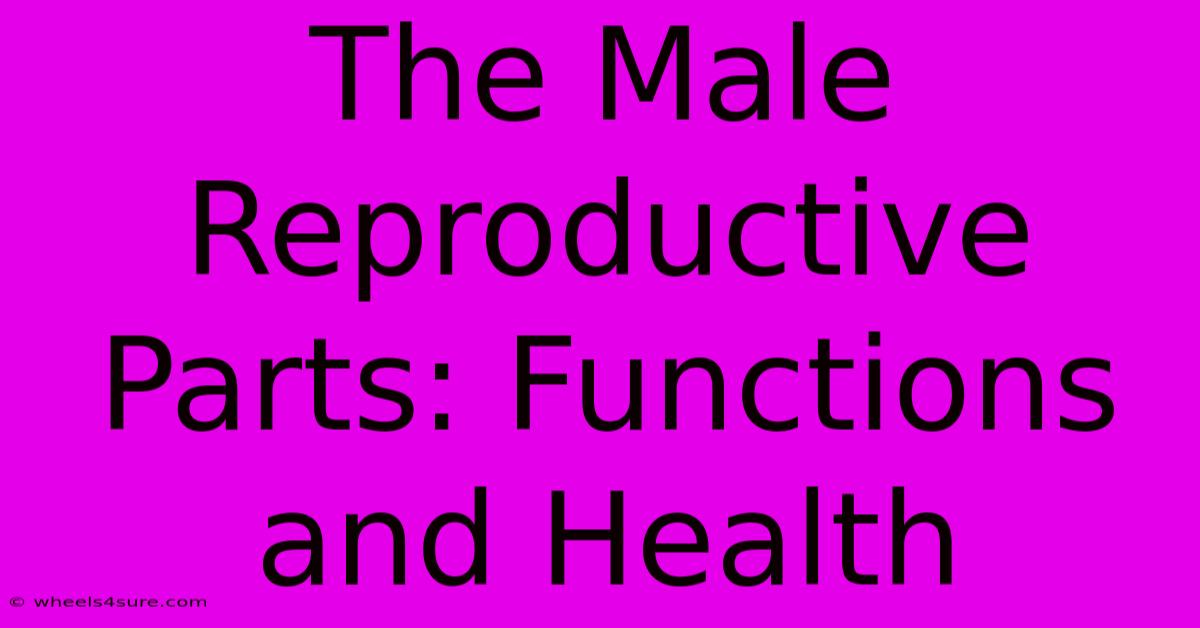The Male Reproductive Parts: Functions And Health

Table of Contents
The Male Reproductive Parts: Functions and Health
Understanding the male reproductive system is crucial for maintaining overall health and well-being. This comprehensive guide explores the anatomy, functions, and common health concerns associated with the male reproductive parts. We'll delve into the intricacies of each component, providing you with valuable knowledge for proactive health management.
Anatomy of the Male Reproductive System
The male reproductive system is a complex network of organs working in harmony to produce, store, and deliver sperm. Key components include:
1. Testes (Testicles):
- Function: The testes are the primary male reproductive organs, responsible for producing sperm (spermatogenesis) and the male sex hormone testosterone. Testosterone plays a vital role in the development of male secondary sexual characteristics (like muscle mass, facial hair, and deeper voice) and maintains sexual function.
- Health Considerations: Conditions like testicular cancer, varicoceles (enlarged veins in the scrotum), and hydroceles (fluid-filled sacs around the testicles) can affect testicular health. Regular self-exams are recommended for early detection.
2. Epididymis:
- Function: This coiled tube sits on top of each testicle. It's where sperm mature and are stored before ejaculation. The epididymis plays a critical role in sperm maturation, allowing them to gain the ability to fertilize an egg.
- Health Considerations: Epididymitis, an inflammation of the epididymis, is a common condition often caused by infection.
3. Vas Deferens:
- Function: These tubes transport mature sperm from the epididymis to the ejaculatory ducts. During ejaculation, powerful muscle contractions propel the sperm forward.
- Health Considerations: A vasectomy, a surgical procedure involving the cutting and tying of the vas deferens, is a permanent form of birth control.
4. Seminal Vesicles:
- Function: These glands produce a fluid that makes up a significant portion of semen. This fluid is rich in fructose, providing energy for sperm, and other substances that support sperm motility and survival.
- Health Considerations: Seminal vesicle inflammation (seminal vesiculitis) can occur due to infection or other causes.
5. Prostate Gland:
- Function: The prostate gland surrounds the urethra and contributes a milky, alkaline fluid to semen. This fluid helps neutralize the acidity of the vagina, creating a more favorable environment for sperm survival. The prostate gland's size increases with age.
- Health Considerations: Benign prostatic hyperplasia (BPH), an enlargement of the prostate gland, is a common condition affecting older men, often causing urinary problems. Prostate cancer is another significant health concern. Regular prostate exams are crucial.
6. Bulbourethral Glands (Cowper's Glands):
- Function: These glands secrete a pre-ejaculatory fluid that lubricates the urethra and neutralizes any remaining acidity before ejaculation.
- Health Considerations: While less frequently affected by serious conditions, these glands can sometimes be involved in infections.
7. Penis:
- Function: The penis is the male organ for sexual intercourse and urination. It contains the urethra, the tube that carries both urine and semen. During sexual arousal, the penis becomes erect due to blood filling its spongy tissue.
- Health Considerations: Erectile dysfunction (ED), the inability to achieve or maintain an erection, is a common condition that can have various underlying causes, both physical and psychological. Penile cancer, though less frequent, is another potential health concern.
8. Scrotum:
- Function: The scrotum is the pouch of skin that holds the testes. Its position outside the body helps maintain the slightly lower temperature necessary for optimal sperm production.
- Health Considerations: Conditions affecting the scrotum can include inflammation (scrotal edema) and hernias.
Maintaining Reproductive Health
Proactive measures are essential for maintaining optimal male reproductive health:
- Regular Self-Exams: Conducting regular testicular self-exams is crucial for early detection of potential issues like testicular cancer.
- Healthy Lifestyle: A balanced diet, regular exercise, and avoiding smoking and excessive alcohol consumption contribute to overall reproductive health.
- Routine Check-ups: Regular visits to a healthcare provider for check-ups and screenings are essential, especially as you age.
- Safe Sexual Practices: Practicing safe sex, including using condoms, helps prevent sexually transmitted infections (STIs) that can impact reproductive health.
- Early Intervention: Seeking medical attention promptly if you experience any concerning symptoms is critical for effective management and treatment.
This information is intended for educational purposes only and should not be considered medical advice. Always consult with a healthcare professional for any concerns regarding your reproductive health. Early detection and appropriate management are key to maintaining a healthy and fulfilling life.

Thank you for visiting our website wich cover about The Male Reproductive Parts: Functions And Health. We hope the information provided has been useful to you. Feel free to contact us if you have any questions or need further assistance. See you next time and dont miss to bookmark.
Featured Posts
-
Ranya Raos Age A Celebration Of Youthful Energy
Apr 07, 2025
-
Albanias Age Of Consent A Socio Cultural Study
Apr 07, 2025
-
The Impact Of Michael Polanskys Net Worth On Society
Apr 07, 2025
-
Travis Barkers Net Worth Is It All About Music
Apr 07, 2025
-
The Influence Of Neil Kinnock On Stephen Kinnocks Career
Apr 07, 2025
